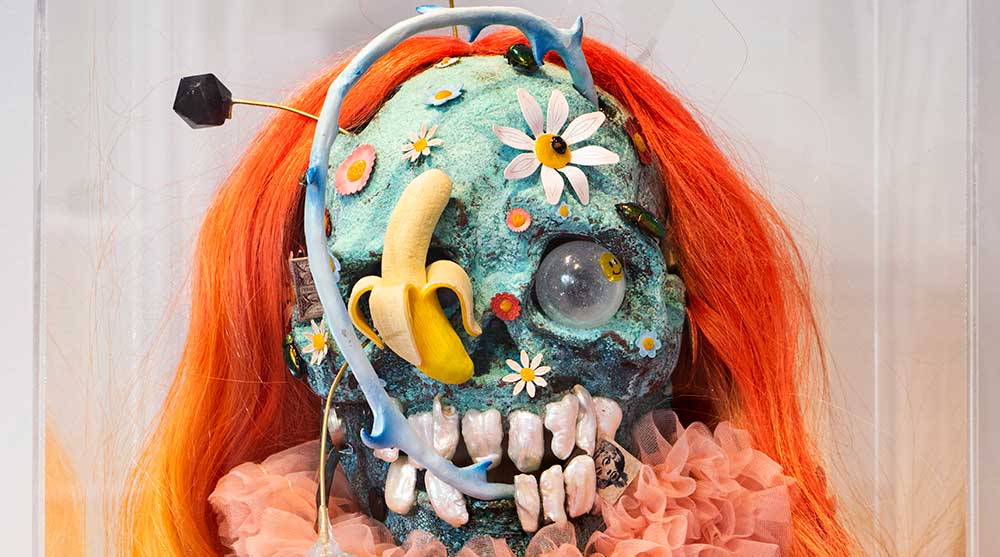
Tai Shani, The World to Me Was a Secret: Caesious, Zinnober, Celadon, and Virescent, 2024, installation view. Photo: Thierry Bal, courtesy of the Jencks Foundation at The Cosmic House.
Jencks Foundation, The Cosmic House, London
1 May – 20 December 2024
by ROCHELLE ROBERTS
In this new site-specific exhibition by the Turner-prize-winning artist Tai Shani, we enter a surreal world that explores what it means to be human. Through a multidisciplinary installation of sculpture, paintings, text and sound, The World to Me Was a Secret: Caesious, Zinnober, Celadon, and Virescent engages with the human body and the creation of life, and draws on the setting of the Charles Jencks-designed Cosmic House, and Jencks’s aesthetic and intellectual interests.
Entering the exhibition space via the spiral staircase from the ground floor above, it is quickly apparent that Shani has created a space that speaks to, and feels a part of, the house. Although the show will feel very familiar to anyone who knows Shani’s work, within the context of The Cosmic House, it takes on a different characteristic. A wonderful synergy develops between the objects and paintings that make up the exhibition, and the numerous objects and decorations that can be found in the rest of the house.
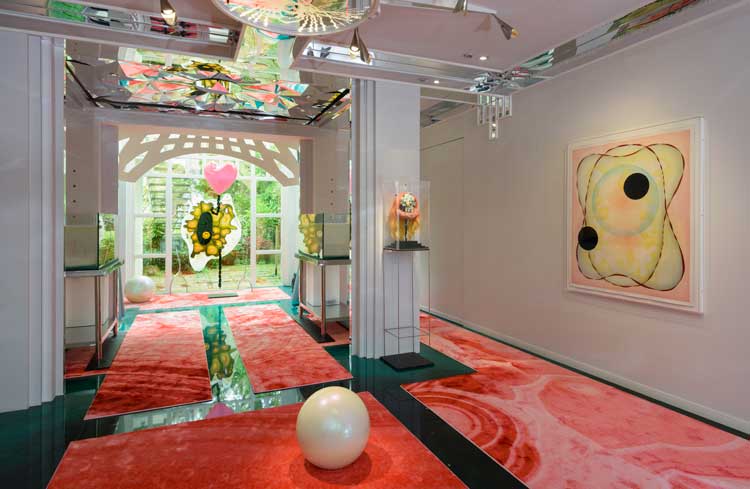
Tai Shani, The World to Me Was a Secret: Caesious, Zinnober, Celadon, and Virescent, 2024, installation view. Photo: Thierry Bal, courtesy of the Jencks Foundation at The Cosmic House.
The fragments of the body in the exhibition, such as the hand sculpture, the skull or the stained-glass eye in the window, recall objects in The Cosmic House, such as the hand on the seat in the winter room, the sculpted eye with an open mouth at its centre, complete with protruding tongue and a line of saliva, that sits framed on the fireplace (both by Madelon Vriesendorp), or the mannequin bust by Charles Jencks that extends from the top of a clock in one of the rooms on the upper floor. Shani also makes reference to the entryway into the exhibition – the spiral solar staircase that leads all the way up through the house and is engraved with the complete set of zodiac signs – by including a small painting of the scorpion star-sign, which was painted by her aunt in 1980.
As well as Jencks and The Cosmic House, another important influence on the exhibition is Mary Shelley’s Frankenstein. This, too, is reflected in the preoccupation with the body – Frankenstein’s creation of the monster through the piecing together of mismatched body parts and the Promethean myth of creating new life from non-living materials. In the context of the house, Shelley’s text and Shani’s engagement with it, also expands on Jencks interest in “ad-hocism”, which is the way in which materials and objects can be used in unexpected or unintended ways with surrealist results. We can also see a direct trace of Shelley’s novel in the title of the exhibition, which is a line taken from the book.
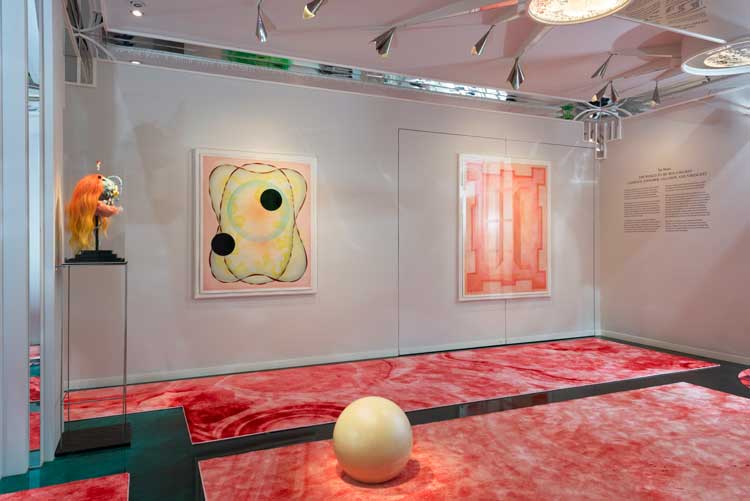
Tai Shani, The World to Me Was a Secret: Caesious, Zinnober, Celadon, and Virescent, 2024, installation view. Photo: Thierry Bal, courtesy of the Jencks Foundation at The Cosmic House.
The exhibition is organised as a kind of fragmented body, evoking the disembodiment of limbs to construct Frankenstein’s monster. In front of the large window looking out into the Time Garden, hangs a stained-glass-like sculpture representing an eye, coloured green and revealing a cell-like structure. It seems to look outwards at the garden and back inwards to the “body” of the exhibition. A pink valentine’s heart balloon appears above it, grounded by a wire bow that forms a stand. Nearby, a sculpture of a hand rests on a plinth in a display case holding various objects, including a candlestick, wood and a syringe-like object.
Further into the space, two glass aquaria stand symmetrically on opposite sides of an arch, suggesting lungs. Each aquarium contains sculptures made from resin and Jesmonite that simultaneously look like a human nervous system and seem to speak to the hues and shapes of coral. Each sculpture sits atop an architectural structure that refers back to Jencksian forms, while the tanks are occupied by blue dwarf shrimp that provide an interesting representation of living things in a show that is so much about the creation of life.
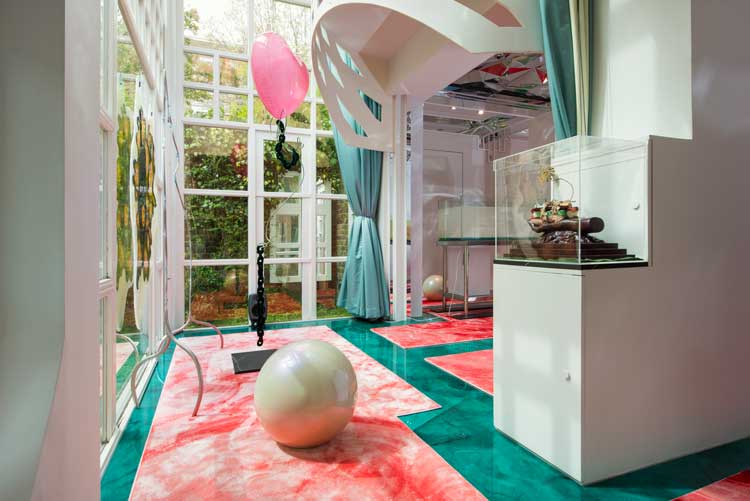
Tai Shani, The World to Me Was a Secret: Caesious, Zinnober, Celadon, and Virescent, 2024, installation view. Photo: Thierry Bal, courtesy of the Jencks Foundation at The Cosmic House.
Behind a column, an elaborate blue skull complete with an orange and yellow wig and a pink neck ruff stands in a glass case. The “head” of the monster, it symbolises both life and death, with bright flowers blooming all over its face. Here, we also see the echo of the heart motif, as small, sculpted hands rise out of the top of the skull, holding a small red heart. A tiny replica of a Frankenstein book is tucked into the skull’s jaw, while a small photograph of the Egyptian queen Tiye is pushed between its pearlescent teeth. It brings to mind the theatrics found in the rest of the house, but also seems to embody the description of the monster “both as a child and also a corpse” from Shani’s accompanying text, the childishness revealed in the yellow smiley face stuck on to the skull’s left eyeball, the part-peeled banana in place of the right eye, which dangles from a gold wire, and the bright wig and ruff, which feel like items to use to play dress-up.
The different shades of green in the exhibition’s subtitle recall the popular image of the monster’s skin as green, which in turn references the fake malachite flooring of the gallery that Jencks created. Shani inverts this with the rugs that cover sections of the floor throughout the space, echoing the swirling pattern of the malachite, but in reddish-pink that brings to mind the flesh and sinew beneath a peeled-back piece of skin. The intention of these rugs is revealed in Shani’s text, in which she writes: “At the climax of a feverish act of love, monster flushed carneous red and oink oink pink, lay on the floor of the cave.” The ceiling of the cave is “a sparkling sky” made true through Jencks design of the room, which incorporates sun-shaped mirror sculptures on the ceiling that reflect and refract the light.
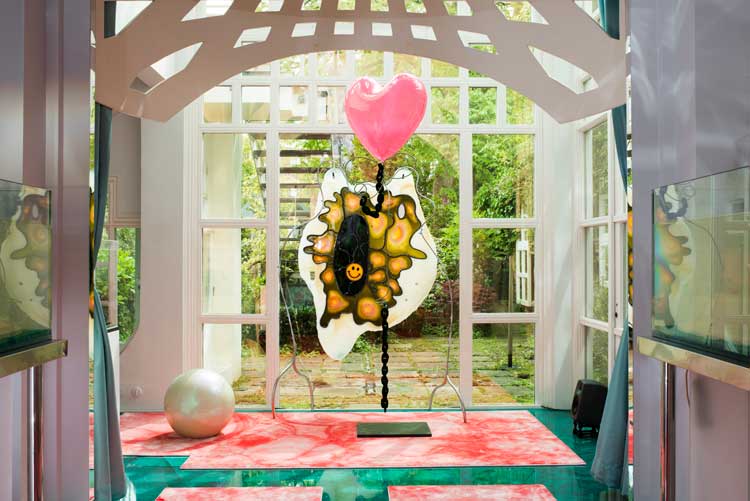
Tai Shani, The World to Me Was a Secret: Caesious, Zinnober, Celadon, and Virescent, 2024, installation view. Photo: Thierry Bal, courtesy of the Jencks Foundation at The Cosmic House.
On the walls hang paintings that evoke the organic shapes of human or plant cells. But there is also something cosmological about them, their undulating shapes and planetary spheres that recur elsewhere in the show – in the pearl sculptures placed on the floor throughout and the spherical orbs that repeat in various sculptures such as the skull’s clear eyeballs and the pink balls in the aquaria. As a backdrop to the visual elements is a soundtrack by Felicita played through four speakers, each with two different sounds (four organs and four angels) that are automated so that the sounds move in and out of time with each other, in what seems like an organic way.
As is often the case with Shani’s exhibitions, there is a sense of world-building and an interest in alternate worlds and modes of existence. This exhibition offers a new perspective on the body’s relationship to organic matter, the Promethean myth of creation and the unique context of The Cosmic House.